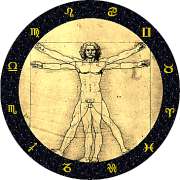Weboteric - Astrology
|
 |

Astrology - Saturn
Time the Greatest Teacher
Ringed jewel in the sky, father time the reaper greets us all eventually.
Its symbol shows the cross of matter above the crescent of receptivity symbolically placed at the Nadir.
Mythology
In the Egyptian legend Isis (Jupiter) swathes Osiris (Saturn).
This became the Greek legend of Saturn too. Cronus (Kronos or Chronus) was warned that his child would be his downfall and took to eating his offspring. Zeus, however, escaped this fate and usurped his father to become king of the gods.
All men are eventually usurped by their children.
The reign of Saturn was celebrated by the poets as the Golden Age which was later celebrated by the Romans as Saturnalia. Along with the Solsitice celebrations, this holiday later became the Christian Christmas.
The Romans took Cronus and transformed him into their Saturn - a god of agriculture - and again the symbol came to represent the conquest of time and death.
One very strange fact about Saturn is that the rings were not clearly seen and understood until Huygens who discovered of Titan in 1655, yet they were known about by the ancient Greeks and Romans as well as other ancient peoples, including some native Americans.
Effects of Saturn
Astrologically Saturn is known as THE GREATER MALIFIC because of its extreme coldness and dryness. It represents LIMITS. It is the furthest planet in the solar system visible to the naked eye and shows where the greatest challenges are to be found, and the hardest lessons learned.
As Saturn takes nearly 30 years to go around the Sun, it will be in any one Sign over a period of about 2½ years. Saturn in a Sign therefore represents cultural and authoritarian influences and trends in society.
It shows the influence of society on the individual, and where in society the greatest efforts are made to build up lasting structures. It is connected with the parents, authorities and rules.
Saturn brings strength through self-limitation, discipline and planning.
Remembered by us as Old Father Time and the Grim Reaper, he represents the ageing process and finally death. So, as the Sun represents life, Saturn represents death.
Often depicted as the planet of loneliness and malevolence, it rules restriction, falls (whether physical or metaphorical), old men, hard work, austerity, delay, poverty, loss, heaviness. It is associated with construction and therefore, buildings and the land.
It rules the father in a night time chart, that is, a chart set for a moment after the sun has set and before it has risen.
How Saturn will manifest its energy depends on the horoscope as a whole. The Sign (and its Element), the House in which if falls, and the Aspects to the other planets will all have a bearing on any interpretation.
Saturn in the horoscope shows where the greatest challenges are to be found, and the hardest lessons learned. This planet shows where rigid systems restrict growth.
Saturn's House position shows where specifically you will experience the greatest challenges and limitations. This is an area which will absorb much of your time. No matter how hard you try to avoid commitment in this area, you will be forced by circumstances to overcome your fears and become an expert in the field indicated.
Aspects to Saturn show areas of the personality where you will feel a lack of confidence. In these areas you will be shy, repressed, desperate for recognition, frustrated. Normally you will build up self-reliance and independence in the part of your character Saturn affects after around 30 years.
Saturn Key Facts |
|
Rules: |
|
Detriment: |
|
Exhalt: |
|
Fall: |
|
Colours: |
Grey, black, dark colours |
Stones & Metals: |
Obsidian and Jet, lead |
Keywords: |
Time, karma, wisdom, ambition |
Astronomy
Saturn is the sixth planet from the Sun and second largest in the solar system.
Noted for its rings, which were described by Huygens in 1655, Saturn is a gas giant like Jupiter and it also has a large family of satellites.
Saturn's rings remained unique in the known solar system until 1977 when very faint rings were discovered around Uranus and shortly thereafter around Jupiter and Neptune.
Daylength (rotation) |
10.66 Hours |
|||||||||||||||||||||||||||||||||||||||||||||||||||||||||
Year length |
29.46 Years |
|||||||||||||||||||||||||||||||||||||||||||||||||||||||||
Distance from the sun (average) |
888.2 million miles (1,429 Million KM) |
|||||||||||||||||||||||||||||||||||||||||||||||||||||||||
Distance from Earth (shortest) |
762.7 million miles (1,277 Million KM) |
|||||||||||||||||||||||||||||||||||||||||||||||||||||||||
Distance from Earth (greatest) |
1,030 million miles (1,658 Million KM) |
|||||||||||||||||||||||||||||||||||||||||||||||||||||||||
Size (Earth=1) |
9.42 |
|||||||||||||||||||||||||||||||||||||||||||||||||||||||||
Mass (Earth=1) |
95.1 |
|||||||||||||||||||||||||||||||||||||||||||||||||||||||||
Moons |
|


Copyright © Weboteric.com 2006 Webdesign by WebOneUK